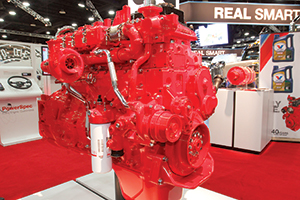Senior Reporter
Cummins Says Its Engines Now Meet ’17 GHG Standard

Independent engine maker Cummins Inc. said it has received Environmental Protection Agency certification on all of its on-highway diesel and natural-gas engines. The engines range from 5 to 15 liters and comply with the second half of federal greenhouse gas and fuel-efficiency Phase 1 standards due to take effect Jan. 1, 2017.
The GHG Phase 1 rule called for an initial reduction of carbon dioxide emissions and improvement in mileage standards by 3%, from a 2010 baseline, by January 2014. The upcoming second step moves that another 3%.
Cummins met the first step a year ahead of schedule. “We are meeting the second step also a year ahead,” Mario Sanchez-Lara, Cummins’ director of on-highway communications, told Transport Topics.
Sanchez-Lara said EPA and the National Highway Traffic Safety Administration “could have received and processed other engines before some of [ours], but as [for] the complete portfolio, we know we are the first.”
EPA did not respond to requests for comment. However, the agency and NHTSA already have proposed a Phase 2 standard.
Detroit Diesel Corp. said it, too, has been certified. Navistar International Corp. said its vocational engines met the second step but had yet to be certified.
Other truck and engine makers said they would be in compliance by a year from now.
“First and foremost, Cummins’ announcement reflects the highly competitive nature of this market and heavy-duty engines in general,” said Allen Schaeffer, executive director of the Diesel Technology Forum. “It’s a chance for a little elbow jabbing and saying, ‘We’re first.’ ”
Meeting on-highway and off-highway emissions standards are major business goals and key to engine makers’ success in the marketplace, he said.
“If you spend any time inside these companies, it’s palpable. You really feel the effort there,” Schaeffer said.
Gary Meteer, an analyst with IHS Automotive, said Cummins is the industry leader in diesel engines in the Classes 3-8 market. That they have met the next Phase 1 requirement a year early “indicates they are serious about maintaining the leadership position they have had since the 2008 calendar year,” he said.
Sean Waters, director of product compliance and regulatory affairs at Daimler Trucks North America, said that as of now, the company “has obtained certification of its vehicles and Detroit Diesel engines to the 2017 GHG standards.”
Market-leading DTNA is the parent company of the Freightliner and Western Star truck nameplates, and engine maker Detroit Diesel.
Ann Duignan, an analyst with J.P. Morgan, said in a note this month that Freightliner relied on Cummins for 25.5% of its engines year-to-date, “a trend that bears watching as original equipment manufacturers aggressively pursue vertical integration, which brought Cummins’ engine penetration down in recent years.”
Lyndi McMillan, communications manager for Navistar Inc., said, “Our N9-10 and our N13 for vocational applications currently meet the 2017 GHG emission levels, and we will certify to the 2017 standard. We continue to make progress on our N13 for linehaul and look forward to making additional announcements as they relate in the future.”
Stu Russoli, highway and powertrain products marketing manager at Mack Trucks, said the company prefers not to comment on product plans for competitive reasons. However, “I can tell you that Mack engines will comply with greenhouse-gas requirements set to take effect in 2017,” he said.
John Moore, product marketing manager for powertrain at Volvo Trucks, said its engines would meet the requirements “slated for implementation in 2017, but we do not discuss future product plans for competitive reasons.”
Mack and Volvo are sister companies within Volvo Group.
Paccar Inc. spokesman Ken Hastings said the company has “successfully exceeded the initial requirements of the GHG Phase 1 regulation . . . [and] will certify its engines to the second step of the GHG Phase 1 regulation to support the Jan. 1, 2017, regulatory requirement, which will add even more benefit beyond those seen today.”
Paccar makes the Kenworth and Peterbilt brand trucks and MX engines.
Cummins’ Sanchez-Lara said he anticipates that EPA will issue the GHG Phase 2 final rule this summer.
The federal government issued its proposal for Phase 2, which calls for more stringent standards for new trucks in 2021, 2024 and 2027 — targets that would be achieved through incremental improvements in fuel economy, and for the first time regulate trailer efficiency. The initial trailer regulation would kick in January 2018 and then tighten along with the truck rule.

